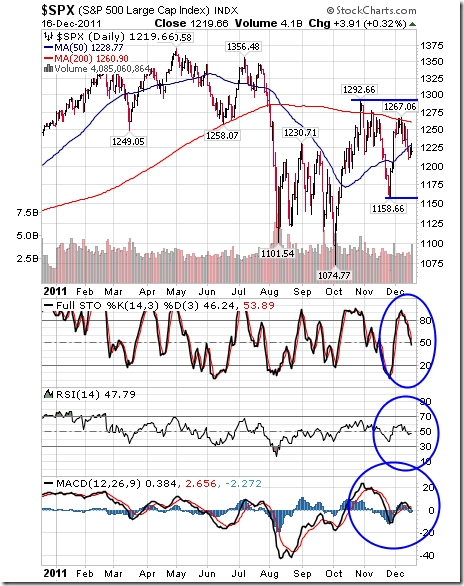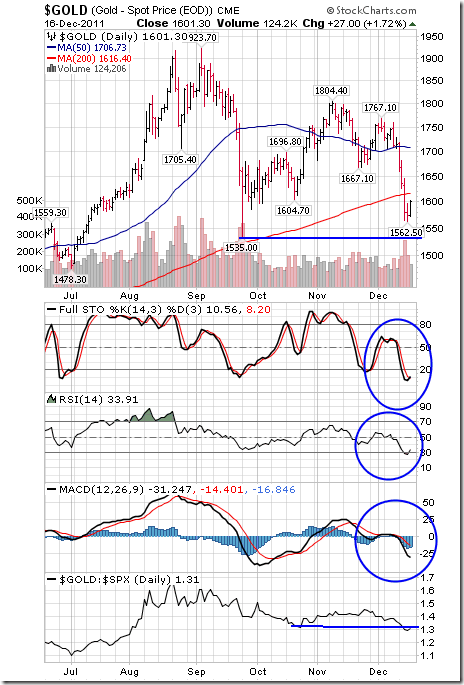Daily Updates
Last week saw a severe breakdown in the Precious Metals sector that is now viewed as marking the start of a bearmarket, and that means the onset of a deflationary episode that is likely to prove more serious than that we witnessed in 2008, because it will involve countries going bust rather than “just” banks and large corporations as was the case in 2008.
At first glance gold’s 3-year chart still doesn’t look too bad, with its price in the vicinity of a still rising 200-day moving average, but last week it broke below this average for the first time since 2008, which is in itself a serious warning, and ominous devolopments on the charts for silver and the Precious Metals stocks indices, strongly suggest that gold is in the process of completing an important top area, which looks like it is taking the form of a bearish Descending Triangle. Momentum as shown by the MACD indicator, is now firmly in negative territory, and failure of the important support level at the lower boundary of the suspected Descending Triangle will lead to a severe decline as shown.

Summary Conclusions & Key Points:
1. Most risk asset markets are trending down with some key exceptions
Bonds/Gold/US dollar [safe havens?]
2. Key changes from 1-month ago
a. Oil weekly trend has turned down
b. Among the 18 currency pairs we track regularly only two continue to appreciate against the US dollar; the Japanese yen and Chinese yuan
S&P 500 Index Trend: Down Comment: Failed resent test of the 55-day week moving average (blue line) i.e. strong resistance there.


The long view
This commentary is a bit longer than my usual, but please bear with me, as I think it might be a useful read for you as I try to answer the question that’s on every investors mind: How much longer will the current volatile sideways market last?
I’ve drawn a trend channel on the DJIA going back to 1900. A trend channel tries to contain the greater amount of movements within a trend to visualize the approximate top zone and bottom zone for that security. You can also use a trend channel to project where future extremes might come into play. For the Dow chart presented here, I’ve made a couple of observations that might be of interest. First, I’ve marked the sideways periods with gray boxes where the market couldn’t penetrate an overhead “ceiling” for an extended period of time. Since 1900, there have been four such periods including the sideways market we’ve been stuck in since 1999. Each of these four sideways periods have been “lost decades” or more—the last sideways market was about 17 years long (1965 -1982). All were characterized by high volatility and large price swings hinged on various worry-inducing events of the time.
Technical, fundamental and seasonal influences point to less volatility and a positive bias for equity markets between now and at least the end of the year. Preferred strategy is to accumulate economically sensitive equities and Exchange Traded Funds with favourable seasonality at current or lower prices.
Strength of the TSX Composite Index relative to the S&P 500 Index turns positive in the first quarter.

The S&P 500 Index fell 35.53 points (2.83%) last week. Intermediate trend is neutral. Support is at 1,158.66. Resistance is at 1,292.66 and near its 200 day moving average at 1,260.90. The Index fell below its 50 day moving average. Short term momentum indicators have rolled over from overbought levels and are trending down.

The TSX Composite Index dropped 399.37 points (3.32%) last week. Intermediate trend is down. Support is at 10,848.19. Resistance is at 12,542.58. The Index trades below its 200 day moving average and fell below its 50 day moving average last week. Short term momentum indicators have rolled over and are trending down. Stochastics already are oversold, but have yet to show signs of bottoming. Strength relative to the S&P 500 Index remains negative.

The U.S. Dollar gained 1.63 last week. An intermediate uptrend was confirmed on a break above resistance at 79.84. The Dollar continues to trade well above its 50 and 200 day moving averages. Short term momentum indicators are overbought, but have yet to show signs of peaking.

Crude oil dropped $6.03 per barrel (6.04%) last week. Intermediate trend turned negative on a break below support at $94.99. Crude also broke below its 50 and 200 day moving averages. Short term momentum indicators are oversold, but have yet to show signs of bottoming.

Gold plunged $112.70 U.S. per ounce last week. It broke support at $1,667.10, its 50 day moving average at 1,706.73 and its 200 day moving average at 1.616.40. Next support is at $1,535.00. Short term momentum indicators are oversold, but have yet to show significant signs of bottoming. Strength relative to the S&P 500 Index has turned negative.

….go HERE for much more commentary and 40 more charts.
{youtube}cL9Wu2kWwSY{/youtube}










